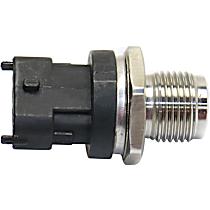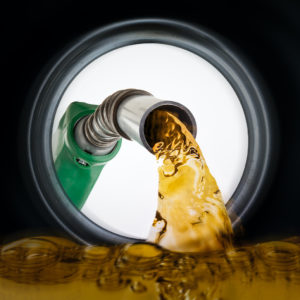On-board diagnostics (OBD) is a network of computers and sensors that gauge a vehicle’s health and performance. This system also alerts the owner of the vehicle of a potential issue, by turning on the corresponding dashboard warning light. At the same time, the system logs one or more trouble codes—a combination of letters and numbers that indicate the location and nature of the problem—in memory.
The P0149 code indicates a probable error with the fuel pump timing. Learn more about the definition, symptoms, and causes of this code with this informative guide.

What Does the P0149 Code Mean?
Diagnostic trouble code (DTC) P0149 stands for “Fuel Timing Error.” This code sets when the powertrain control module (PCM) has detected a fuel pressure signal indicating a malfunction with the fuel pump timing. The PCM may also store this code if the actual fuel pressure and the commanded fuel pressure do not correlate. This code is more commonly seen in diesel vehicles than in gas-powered vehicles.

Many modern, direct-injection diesel engines have a mechanical fuel pump that’s driven by the crankshaft. This fuel pump is often built to be small enough to fit underneath the intake manifold. Components such as the high-pressure pump, fuel timing solenoid, and fuel pressure control actuator may also be integrated inside this pump. A fuel pressure sensor may also be found near this assembly.
In a typical diesel fuel system, the fuel pump is timed according to the position of the crankshaft and provides a high-pressure injection pulse at a precise point and interval and for each cylinder of the engine. This process helps overcome the high compression ratios associated with diesel engines.
A toothed sprocket, which is aligned with another toothed sprocket on the crankshaft, pulses the fuel pump. The timing of these sprockets is critical to fuel pump timing and fuel delivery. The P0149 code may also set if the sprockets get misaligned by even a single tooth.
As for the other parts of the fuel pump system, the PCM uses data on engine RPM (revolutions per minute) and load to calculate fuel timing advance. To allow direct injection timing to be advanced according to speed and load, the PCM controls an electronic fuel timing solenoid.
Meanwhile, the PCM controls an electronic fuel pressure regulator, which is responsible for controlling fuel pump pressure. A sensor monitors the fuel pressure and provides the PCM with an actual reading. This enables the PCM to continue to calculate fuel pump timing and to monitor fuel pressure requirements.
Note: The definition of code P0149 may be different depending on the vehicle manufacturer. Consult the appropriate repair manual or repair database for the exact code definition.

What Are the Possible Causes of the P0149 Code?
The P0149 code, like many other trouble codes, has a lot of possible causes. This is because trouble codes can only indicate the location and nature of a potential problem but not its root cause. Listed below are some of the likely reasons why P0149 sets:
- Faulty fuel timing solenoid
- Misaligned timing marks on mechanical sprockets
- Defective fuel pressure sensor
- Fuel pump failure
- Fuel pressure control actuator malfunction
- Leaks or air in the fuel system
- Faulty PCM
- PCM programming error
What are the Common Symptoms of the P0149 Code?
Aside from storing a diagnostic trouble code, the vehicle’s computer system may also illuminate the malfunction indicator lamp (MIL) to warn the owner of a potential problem. Some codes may not exhibit signs other than an active MIL. However, for codes such as the P0149, other signs may be present. Below is a list of the most common symptoms of the P0149 code:
- No start condition
- Reduced engine performance
- Increased fuel consumption
- Strong fuel odor
- Vehicle may enter a limp-home mode
- Excessive exhaust smoke
- Additional fuel system codes may also be present

How to Diagnose the P0149 Code
In order to fix a trouble code, the root cause must first be determined. Because trouble codes, such as the P0149 code, have multiple possible causes, proper diagnosis may be a challenging task.
If you want to know more about the P0149 code and how high-pressure fuel systems work, you’ll need accurate and reliable resources, such as vehicle-specific repair manuals and databases.
How to Fix the P0149 Code
Trying to fix trouble codes, in general, is a time-consuming project because you need to eliminate all other likely causes to get to the root issue of the problem. If you encounter the same code on two different models of the same make, the solution may still differ because the root problem for each may be different. What fixes the P0149 on a Ford Focus may not work to solve the P0149 on a Ford Transit.
In addition, vehicles have different terminology, components, and repair procedures depending on the manufacturer. The setting conditions for the P0149 on Nissan vehicles may be different from the setting conditions for Ford vehicles.
Before fixing the P0149 code, it’s a good idea to consult reliable sources of information to understand the issue better. If you’re unsure about how to address trouble codes on your own, always consult a certified technician or mechanic to avoid costly mistakes and even accidents down the line.
While fuel pump replacement is a common solution to this trouble code, it may not apply to all cases. Determining the exact root cause of the issue is still required before attempting any repairs.
Other Notes About P0149 by Richard McCuistian, ASE Certified Master Automobile Technician
There was a time when the primary element of the engine control fuel system that was a “closed loop” was the relationship between fuel delivery and oxygen sensor input, with the ECM/PCM acting as the arbiter between the two. The O2 switches rapidly from rich to lean and the fuel trim follows it back and forth. This began on U.S. domestic vehicles with feedback carburetors that could alter the air-fuel mixture using solenoids that either operated carburetor metering rods in air bleeds.
Electronically fuel injected vehicles initially had mechanical fuel pressure regulators that returned excess pressure from the fuel rail to the tank. But electronic fuel rail sensors began to appear in the ‘90s, systems became “returnless,” and variations of that kind of system have since become the order of the industry on most vehicles.
When a fuel rail pressure sensor is used, there is a closed loop that includes a fuel control module or some type of solenoid working in conjunction with the ECM/PCM to control the fuel pressure. Fuel rail pressure sensors and returnless systems began to appear in the mid-1990s, but many returnless systems simply have a mechanical fuel pressure regulator integral with the fuel pump in the tank.
Gasoline direct injection (GDI) and common rail (CR) diesels have a fuel rail pressure sensor and a control solenoid built into their high pressure pumps. The ECM sets a pressure target based on engine load requirements on the fly and very rapidly commands the solenoid or module to do what it has to in order to meet that pressure target.
The caveat here is that, while closed loop fuel rail pressure control systems are very common on today’s platforms, this particular diagnostic trouble code, P0149, doesn’t appear on the vast majority of vehicles.
The definition of this code actually sounds like it’s referring to the timing of the fuel delivery, but since fuel delivery is totally electronic, that definition makes very little sense.
Where to Buy Quality Replacement Parts to Fix P0149 Causes
Code P0149 is a rather troublesome diagnostic code, and you should identify and fix the root causes behind it as soon as possible. Otherwise, your vehicle will continue to experience reduced fuel efficiency and engine performance. It might even not start. Thankfully, if you need help finding durable replacement parts, CarParts.com has got your back.
CarParts.com is proud of our vast catalog of quality aftermarket parts, such as fuel pressure sensors and fuel pumps. If you’re having a hard time navigating our website, our friendly and helpful customer service team is on standby around the clock to assist. They’ll help you use the built-in vehicle selector, and tell you all about the best deals on our site.
Solve your vehicle’s fuel timing issues today. Place your order for a new fuel pressure sensor or other replacement parts at CarParts.com.
Products Mentioned in this Guide
Any information provided on this Website is for informational purposes only and is not intended to replace consultation with a professional mechanic. The accuracy and timeliness of the information may change from the time of publication.


 Fuel Pressure Sensor
Fuel Pressure Sensor
 Fuel Pump
Fuel Pump
















